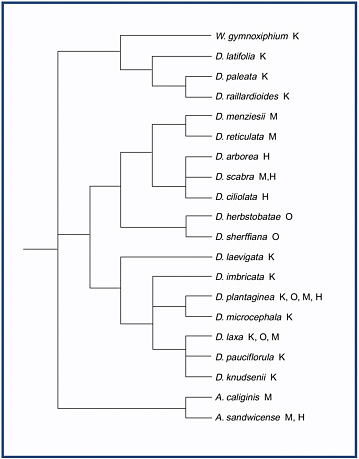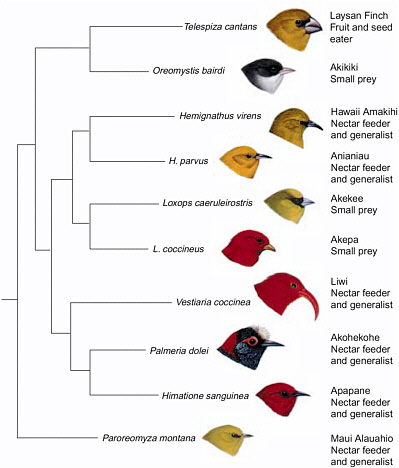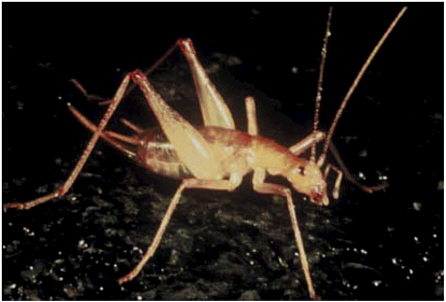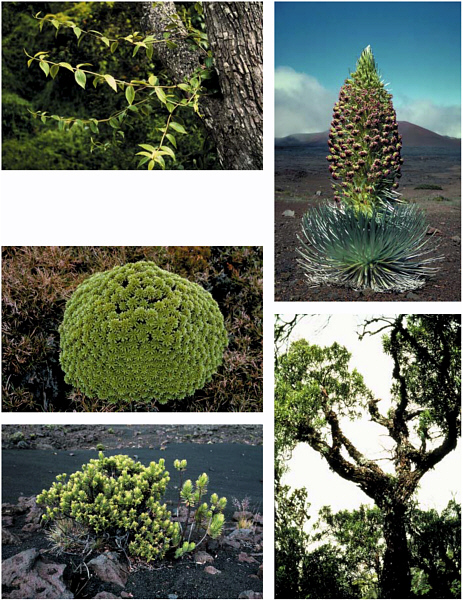Many Other Species Have Undergone Adaptive Radiations in Hawaii
While the adaptive radiation of the drosophilids in Hawaii has resulted in a remarkable number of species, other radiations have produced descendants with an even greater range of physical characteristics. The 30 species of plants belonging to what is called the silversword alliance are a superb example.
For decades, botanists had known that all of these species are related because their leaves and flowers share certain characteristics, which is why the species are termed an “alliance.” But in other ways the plants are so different that the nature of this relationship remained obscure. The 30 members of the alliance include trees, shrubs, mats, vines, and the rare and magnificent flowering silverswords that live on the high slopes of Haleakala in Maui and Mauna Kea in the Big Island (see Figure 13). They occupy habitats ranging from near sea level to the upper limits of vegetation on mountains and from semiarid desert areas to thick rainforests.
In the 1980s, biologists studying the genetics of these species realized that they are far more closely related than they appear. In fact, all appear to be descended from a single ancestral species that arrived on the Hawaiian islands millions of years ago (Panel 3). Today the closest non-Hawaiian relative of the silversword alliance is a small, daisy-like plant called a tarweed that grows on the west coast of North America. The fruit of this plant has sticky appendages that could easily have allowed the seeds of an ancestral plant to hitch a ride on a migratory bird.
As with the drosophilids, the descendents of the original colonizing species diversified dramatically as they underwent multiple founder events and spread into new environments. On Maui and the Big Island, for example, several species within the silversword alliance have adapted to the drier environments of higher elevations. All of these species are able to maintain water pressure within their leaves and stems even as the water content of the plant drops, which helps them survive in drier habitats.
Many other species of plants and animals in Hawaii also derive from adaptive radiations.
-
About 50 living and extinct species of the birds known as honeycreepers have been identified in Hawaii. All evolved from a single finch-like colonist species with a relatively small bill. Today, the members of this radiation have a wide variety of bill shapes that are each specialized for a particular kind of food (see Figure 14).
-
About 240 species of crickets have evolved from the separate arrival in Hawaii of a tree cricket, a sword-tail cricket, and a ground cricket. Among these species are several species that have adapted to subterranean life within underground lava tubes in Maui and the Big Island (see Figure 15). These species have reduced coloration, small eyes, and a clear exoskeleton.
-
Two genera of violets—Viola with seven species, and Isodendrion with four—derive from two separate introductions, each of which was followed by a moderate degree of adaptive radiation.
Altogether, the approximately 1,700 species of native Hawaiian plants are descended from about 300 separate species that colonized the islands. The 10,000 species of native Hawaiian insects may be descended from only 350 to 400 separate founders. Biologists are now studying the different patterns of adaptive radiations seen in Hawaii to better understand the factors that influence evolutionary diversification.
|
Panel 3 High on the Hawaiian volcanoes of Haleakala and Mauna Kea is a remarkable plant that attracts a steady stream of admirers from around the world. Argyroxiphium sandwicense, commonly known as the silversword, is for most of its life a globe-shaped plant with rigid leaves covered by dense silver hairs. After living for anywhere from 15 to 50 years, the plant produces a spectacular stalk up to six feet tall covered with hundreds of maroon flowers; soon after producing a new generation of seeds, it dies. Near extinction in the 1920s because of destruction by humans, goats, and cattle, the silversword is now protected and is gradually increasing in numbers. The silverswords that grow on the flanks of Haleakala and Mauna Kea represent one of five separate silversword species found on Maui and the Big Island (one of these species is now extinct). Recognizing similarities in their leaves and flowers, botanists have known for decades that these five species are related to 25 other Hawaiian plant species. Two of these other species belong to the genus Wilkesia and grow only on the island of Kauai. The other 23 species belong to the genus Dubautia and grow from Kauai to the Big Island. In the late 1980s, botanists Bruce Baldwin, Donald Kyhos, and Gerald Carr, after comparing the chromosomes and DNA of the silversword species with that of various California species, succeeded in producing vigorous hybrids between the Hawaiian plants and a California tarweed, demonstrating that they are closely related. Further genetic research has demonstrated that all the members of the silversword alliance are descended from a single ancestral species that colonized the Hawaiian islands. Since then, biologists have used the genetic differences within the alliance to derive an evolutionary phylogeny showing how the species are related. These data suggest that there was a single species from which all the current members of the alliance evolved and that this species lived on what is now the island of Kauai about five million years ago. |
 An evolutionary tree based on DNA sequences of silversword alliance members shows how current species are descended from a common ancestral species. Only some of the known species are shown here. Letters following each species indicate the island or islands on which the species grows today (K = Kauai; O = Oahu; M = Maui, Lanai, and Molokai; and H = the Big Island of Hawaii). According to the DNA data, the ancestral species split into two separate species approximately five million years ago. One of these species eventually gave rise to the Argyroxiphium species that now grow on Maui and the Big Island. The other species evolved into the two Wilkesia species that today are found on Kauai and the 23 Dubautia species found on all the islands. (Diagram adapted from Bruce G. Baldwin and Michael J. Sanderson, “Age and Rate of Diversification of the Hawaiian Silversword Alliance (Compositae),” Proceedings of the National Academy of Sciences 95:9402-9406, 1998.) |

Figure 14
Species of Hawaiian honeycreepers descended from a common ancestor, some of which are shown here, have evolved many different bill shapes and food sources. (Paintings copyright H. Douglas Pratt, The Hawaiian Honeycreepers: Drepanidinae. Oxford: Oxford University Press, 2003. Diagram adapted from T.J. Givnish and K.J. Sytsma, eds., Molecular Evolution and Adaptive Radiation. Cambridge: Cambridge University Press, 1997.)

Figure 15
Species of crickets that live underground in Hawaii have reduced eyes and pale color compared to the surface-dwelling species that colonized the islands. (Photograph courtesy of William P. Mull.)






